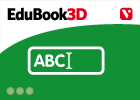Cargando...
Recursos educativos
-
Nivel educativo
-
Competencias
-
Tipología
-
Idioma
-
Tipo de medio
-
Tipo de actividad
-
Destinatarios
-
Tipo de audiencia
-
Creador
Lo más buscado
- Imprimir material quinto
- Género y número
- Uso de c, s y z
- Experimentos de acústica
- Actividades de fabulas
- Problemas aditivos y multiplicativos
- Lecturas interactivas
- Día mundial del agua
- Capitales del Mundo
- Actividades artísticas para niños
- Manualidades infantiles para niños
- Repaso de fisica
- Centrales eléctricas
- Experimentos en cuarto
- Repaso acentuación primaria
-

Contesta. Els pobles preromans: els ibers
EduBook Organización
- 2853 visitas
Recorda el que has treballat en aquest apartat i contesta: A quina zona de la Península Ibèrica habitaven els pobles ibers? Per què diem que al primer mil·lenni a.C. la Península Ibèrica va entrar…
-

Avaluació inicial T10 02 - Els animals
EduBook Organización
- 2844 visitas
Llegeix aquestes frases i escriu V (veritable) o F (fals) segons el que correspongui: Els invertebrats tenen ossos. Les anemones i les meduses són celenterats. Les esponges viuen a l'aigua. Els…
-

Continental climate and vegetation
EduBook Organización
- 2846 visitas
Continental climate The continental climate is characteristic of the Meseta, the Ebro valley and inland areas of Andalusia and Catalonia. These areas are located in the interior of the landmass. The sea…
-

Match. Cave paintings from Cantabria and Levante
EduBook Organización
- 2848 visitas
Match these characteristics of cave paintings from the Iberian Peninsula with the region where they are found: They show animals, painted in bright colours. ➝ They show people hunting, dancing and…
-

True/false. Agriculture, mining and trade in Roman times
EduBook Organización
- 2855 visitas
Decide if the following statements are true or false: The Romans introduced highly developed farming methods. ➝ They used animals to plough the land. ➝ Wheat, grapes and olives were not grown in…
-

-

Answer. Pregnancy and birth
EduBook Organización
- 2850 visitas
Remember what you have studied in this section and answer the questions: How do sperm move? When and where does fertilisation occur? What is the function of the umbilical cord? After how many months of…
-

Answer. From zygote to birth
EduBook Organización
- 2849 visitas
Remember what you have studied in this section and answer the questions: How are oviparous animals born? Which animals have simple eggs? Which animals have more complex eggs? Where do the embryos of…
-

Completa. El ejército romano
EduBook Organización
- 2851 visitas
Completa estas frases con las siguientes palabras: estacada escudo ciudades legiones cónsul jinetes torres de vigía lanza altar infantería campamentos foso tiendas Para conquistar el Imperio, Roma se…
-

Evaluación final T6 03 - En tiempos de los romanos
EduBook Organización
- 2849 visitas
¿Cuándo y cómo conquistaron los romanos la Península Ibérica? ¿Qué nombre le dieron? ¿Cuántos años duró esta conquista?
Te estamos redirigiendo a la ficha del libro...













